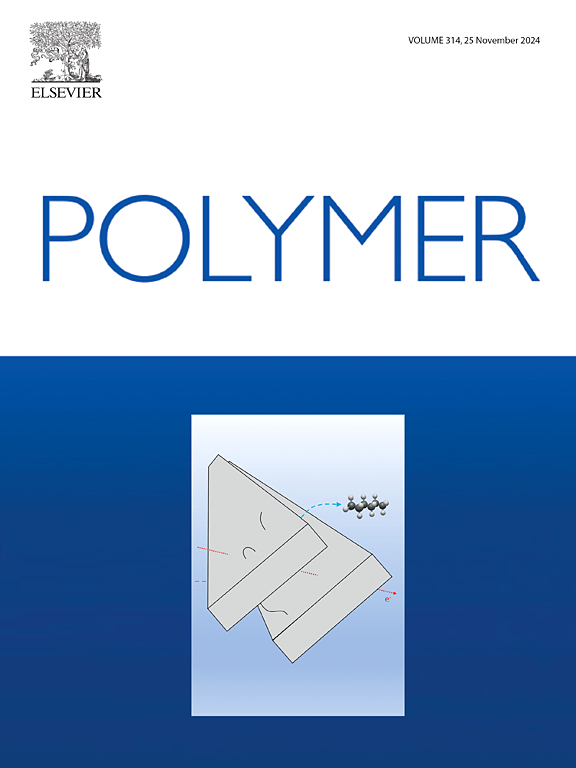The unique dynamics of water and polymer in polyethylene imine–water mixtures across the glass transition
IF 4.1
2区 化学
Q2 POLYMER SCIENCE
引用次数: 0
Abstract
This study investigates the molecular dynamics of polyethyleneimine (PEI)-water mixtures (100–50 wt% PEI) at subzero temperatures without ice formation, leveraging broadband dielectric spectroscopy. PEI's electrolytic nature and hydrogen bonding capabilities influence relaxation times (τ), strength (Δε), glass transition temperature (Tg), and fragility (m). Pure PEI exhibits slower α-relaxation from cooperative polymer segment motion and faster Johari-Goldstein (JG)-β-relaxation. In addition, ν process due to water molecules was observed from 95 wt% of PEI downwards. PEI-water mixtures exhibit unique relaxation dynamics compared to other polymer-water systems, such as polyvinyl pyrrolidone (PVP) and poly (vinyl methyl ether) (PVME), showing minimal plasticization by water down to a critical PEI concentration of 70 wt%. Strong hydrogen bonding between PEI and water increases Tg and ν-process relaxation times, preventing ice crystallization. These interactions yield concentration-independent relaxation dynamics (τα, τν, Tgν and Tgα) in 95-70 wt % PEI-water mixtures compared to those in PVP and PVME-water mixtures. X-ray diffraction (XRD) patterns confirm these findings: amorphous PEI shows a broad peak at 2θ = 20°, which weakens and splits at 70 wt% PEI into peaks at 2θ = 15° and 24°, indicating amorphous ice. Molecular dynamics (MD) simulations reveal a cohesive energy density of 1.50 × 109 J/m3, dominated by electrostatic interactions (1.40 × 109 J/m3) with minor van der Waals contributions (9.9 × 107 J/m3). FTIR spectroscopy highlights a broad, intense peak (3750–2500 cm−1), confirming hydrogen bonding's role in PEI's structure and dynamics. These findings underscore PEI's unique capacity to prevent ice formation and maintain water at low temperatures despite its low Tg.


水和聚合物在聚亚胺-水混合物中玻璃化转变的独特动力学
本研究利用宽带介电光谱研究了在零下温度下不结冰的聚乙烯亚胺(PEI)-水混合物(100-50 wt.% PEI)的分子动力学。PEI的电解性质和氢键能力影响弛豫时间(τ)、强度(Δε)、玻璃化转变温度(Tg)和脆性(m)。纯PEI表现出较慢的α-弛豫,而更快的Johari-Goldstein (JG)-β-弛豫。此外,从95 wt.%的PEI向下观察到由水分子引起的ν过程。与其他聚合物-水体系(如聚乙烯吡咯烷酮(PVP)和聚乙烯基甲基醚(PVME))相比,PEI-水混合物表现出独特的弛豫动力学,在PEI临界浓度为70 wt.%时,水的塑化作用最小。PEI和水之间的强氢键增加了Tg和ν-过程松弛时间,防止冰结晶。与PVP和pvme -水混合物相比,这些相互作用在95-70 wt. %的pii -水混合物中产生了与浓度无关的弛豫动力学(τα, τν, Tgν和Tgα)。x射线衍射(XRD)图证实了这些发现:非晶态PEI在2θ = 20°处表现出宽峰,在70 wt.% PEI处减弱并分裂成2θ = 15°和24°的峰,表明非晶态冰。分子动力学(MD)模拟表明,内聚能密度为1.50 × 109 J/m3,静电相互作用(1.40 × 109 J/m3)占主导地位,范德华作用较小(9.9 × 107 J/m3)。FTIR光谱突出了一个宽而强的峰(3750-2500 cm-1),证实了氢键在PEI结构和动力学中的作用。这些发现强调了PEI的独特能力,可以防止冰的形成,并在低温下保持水,尽管它的Tg很低。
本文章由计算机程序翻译,如有差异,请以英文原文为准。
求助全文
约1分钟内获得全文
求助全文
来源期刊

Polymer
化学-高分子科学
CiteScore
7.90
自引率
8.70%
发文量
959
审稿时长
32 days
期刊介绍:
Polymer is an interdisciplinary journal dedicated to publishing innovative and significant advances in Polymer Physics, Chemistry and Technology. We welcome submissions on polymer hybrids, nanocomposites, characterisation and self-assembly. Polymer also publishes work on the technological application of polymers in energy and optoelectronics.
The main scope is covered but not limited to the following core areas:
Polymer Materials
Nanocomposites and hybrid nanomaterials
Polymer blends, films, fibres, networks and porous materials
Physical Characterization
Characterisation, modelling and simulation* of molecular and materials properties in bulk, solution, and thin films
Polymer Engineering
Advanced multiscale processing methods
Polymer Synthesis, Modification and Self-assembly
Including designer polymer architectures, mechanisms and kinetics, and supramolecular polymerization
Technological Applications
Polymers for energy generation and storage
Polymer membranes for separation technology
Polymers for opto- and microelectronics.
 求助内容:
求助内容: 应助结果提醒方式:
应助结果提醒方式:


